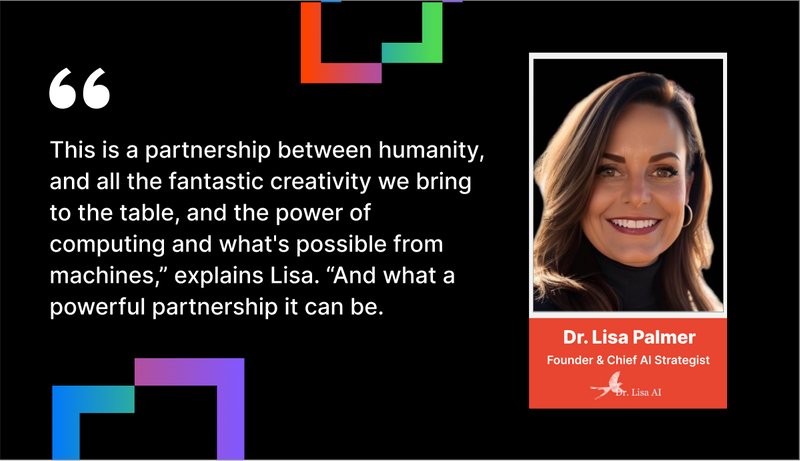AI in Marketing: Unpacking the Promise and the Pitfalls

Table of Contents
Maximize Your Marketing ROI
Join 10,000 other marketers already getting the best tips on running engaging events that boost pipeline and create raving fans.
AI is rocking the marketing world. And really, the entire world.
“The wave is crashing across all industries, all levels of roles from top executives to frontline employees,” says Dr. Lisa Palmer, CEO and founder of Dr. Lisa AI. She compares generative AI (GenAI) to a tidal wave. 🌊
In less than a year since GPT was introduced, 70% of CEOs have ranked investment in GenAI as a top priority.
But if you still feel lost at sea, you’re not alone. Though the evangelists seem to believe AI is the answer to everything, the truth is, many of us are still trying to find practical ways to use it.
Will AI live up to its potential? Or are we simply at the peak of the hype cycle? At the recent Goldcast AI Summit, we sat down with three experts to get their takes on whether we should buy in, or call bull$#t.
Rather watch than read? View the full session on-demand.

Is AI worth the hype?
The answer is one of those annoying “yes and nos”.
From blockchain technology to the Internet of Things (IoT), AI experts like prompt engineer and MIT alum, Li Sun, know that AI isn’t the only disruptive technology on the block. So, why the hype?
“What's different about AI is that it has what we call mass adoption,” Li explains. “When generative AI came out, anybody could go on it and start using it.” As with other disruptive technologies, like the internet, Li believes the hype around AI will eventually fade.
At that point, AI won’t be considered this major singular thing companies “must adopt”. It will simply be business as usual. “We're going to have companies coming out, the Googles and Amazons of AI, adding real serious value and changing the way our societal norms are going to happen,” says Li.
Noah Kravitz, partner at AI Ready and host of the NVIDIA AI podcast agrees. “There's a huge gap right now between potential and how it's actually being turned into business value—but the innovation is not going to stop,” he says.
As the world of AI moves from buzz to business as usual, what are some of the things you should be using it for? And, perhaps more importantly, what should you avoid?
Where AI shines: text, code, and graphics
In both his consulting business and his work on the podcast, Noah has witnessed a range of business use cases for AI. From life sciences workflows to understanding imagery from the James Webb telescope, the potential is incredible.
But in his own day-to-day workflows, Noah’s use of AI is about as practical as it gets. “For me personally, it's most useful as a summarizing tool and brainstorming partner,” he explains.
With its easy chat experience and vast realm of knowledge, GenAI has become something of a co-pilot in the creative process.
Li categorizes three core ways AI can save time:
- Text
- Code
- Graphics
Whether it’s creating your blogs, writing solid code for your next feature release, or generating images and videos—most of us will find ourselves in at least one of these key use cases.
And according to Dr. Lisa, that’s the perfect place to start. “Start practically,” she suggests. In her work consulting companies across a variety of industries, she’s witnessed the AI overwhelm firsthand. “People are so overwhelmed at all of what’s possible that they're a bit paralyzed, and so they don't do anything.”
Her advice? Pick one thing. If you write a lot of emails, use GenAI to help you draft your email copy. Over time, you might ask it to give you new frameworks for future sequences and let the use cases develop organically from there.
Soon we’ll take a closer look at more practical tips from our experts. But first, where should you not be using AI?
📚Read Next: AI In The Enterprise: Unlocking Opportunities for Growth and Innovation
Where AI falls flat: dissemination, hallucinations, and impact
There are myriad types of machine learning under the broad umbrella of AI. The first thing to know is that each tool comes with its own risks and limitations.
“It's a super versatile tool. And so what you don't want to do is use it as a hammer when it really should be being used as a screwdriver,” explains Lisa.
From a technical perspective, Li sees two core limitations with GenAI:
- Dissemination: Using AI to spread fake news
- Hallucination: When the AI itself is making up things that aren’t true
“The way I would think about this is reverse engineering and thinking about the consequence of error. Whether it's AI, machine learning, or anything else, every type of model has an error rate. So, what is the consequence of your error?” Li explains.
Netflix recommending stuff you don’t want to watch is annoying, but it’s nothing you won’t survive. A doctor using AI to diagnose a patient—that’s a huge deal.
Rather than seeing it as a trusted expert who knows everything, Lisa suggests thinking of GenAI as a “wildly informed digital concierge.”
“Make sure you're asking it for appropriate assistance, just like you would a concierge,” she explains.
From paralysis to partnership: Practical ways to use AI in marketing
To effectively move from AI paralysis to sticking with one thing long enough to get value from it, start by assessing your current view on AI. Do you see it as a partner or a threat?
“This is a partnership between humanity, and all the fantastic creativity we bring to the table, and the power of computing and what's possible from machines,” explains Lisa. “And what a powerful partnership it can be.”

Here are some of the ways marketing teams are starting to see real value from AI.
Find data insights faster
You already know AI excels at all things analytics. Its ability to parse complex data, recognize patterns, and identify insights quickly is unparalleled. For marketers, AI can get you from the noise to the signals much faster than you would on your own.
Save time in the creative process
With its strength in text generation, coding, and graphics, GenAI is a brilliant creative partner. Even when working on a strategic problem, the right prompts and frameworks can make it possible to get high quality creative ideas from your partnership with AI.
Get a brainstorming buddy
AI is an unmatched summarizer and brainstorming partner. Use it to stimulate creative and strategic thinking in your ideation process. As prompt engineering evolves, new features will emerge to help you better interact with AI for even better output.
Use the right frameworks
AI experts regularly use frameworks like a Strengths, Weaknesses, Opportunities, and Threats (SWOT) analysis to give better context to large language models like ChatGPT. Whether you use a TRIZ framework to help you develop new products or the Attention, Interest, Desire, and Action (AIDA) formula to connect with your audience in email copy, the right framework can help AI become a better partner.
Use caution
Responsible AI practices are a must, especially at the enterprise level. Set a standard for ethical and cautious use of AI. If possible, create a dedicated team or task force to monitor and support guidelines for handling sensitive data when using GenAI and ensuring there is always human supervision present.
Start small
AI’s potential is genuinely overwhelming. Start with small steps to gradually make a smooth transition. “Pick one tool and start to get comfortable using it,” advises Lisa. “Once you do that, you lower your own barrier to resistance. Then you really open up the creative ideas of how you can apply it.”
Making it work with AI
From the rise of edge AI to the emergence of roles like Chief AI Officer, change is the only constant when it comes to GenAI. But that doesn’t mean you have to learn every new tool overnight.
“AI’s been around and it's not going anywhere,” says Noah. With new interaction models and user interfaces, the way we use AI is bound to shift and change. Learn the limitations of each new tool or model, then give yourself the space to experiment with it until you find the use cases that work for you.

Transform Your Video Marketing with AI
Stay In Touch
Platform
Resources
© 2025 Copyright Goldcast, Inc. All rights reserved.





 Upcoming Events
Upcoming Events Event Series
Event Series On-Demand Events
On-Demand Events

